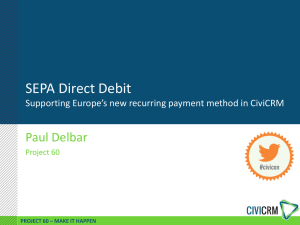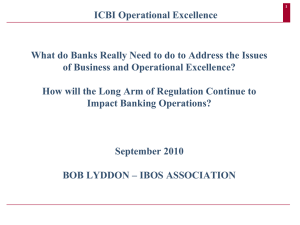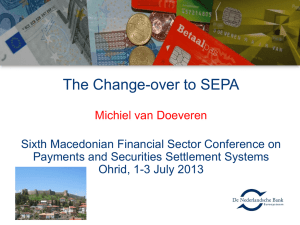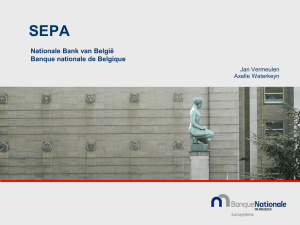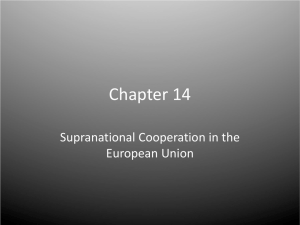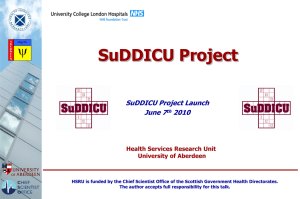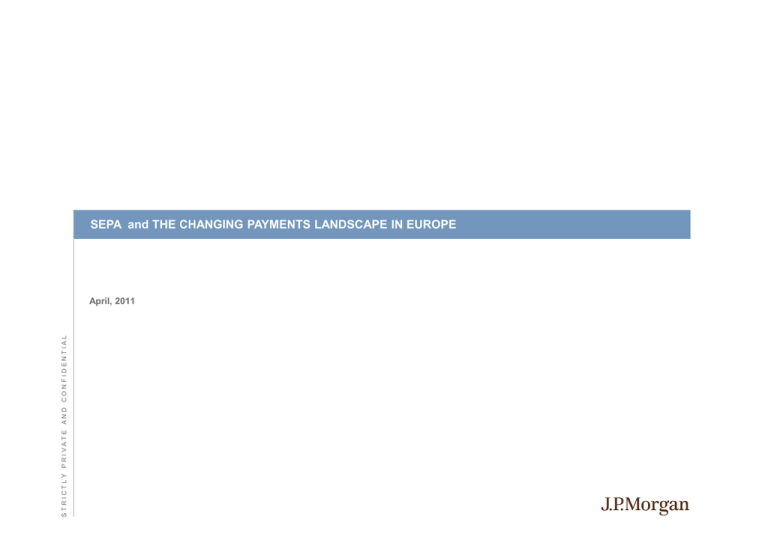
SEPA and THE CHANGING PAYMENTS LANDSCAPE IN EUROPE
STRICTLY PRIVATE AND CONFIDENTIAL
April, 2011
English_Commercial Bank
This presentation was prepared exclusively for the benefit and internal use of the J.P. Morgan client to whom it is directly addressed and delivered including such
client’s subsidiaries, (the “Company”) in order to assist the Company in evaluating, on a preliminary basis, certain products or services that may be provided by
J.P. Morgan. This presentation is for discussion purposes only and is incomplete without reference to, and should be viewed solely in conjunction with, the oral
briefing provided by J.P. Morgan. It may not be copied, published or used, in whole or in part, for any purpose other than as expressly authorised by J.P. Morgan.
The statements in this presentation are confidential and proprietary to J.P. Morgan and are not intended to be legally binding. Neither J.P. Morgan nor any of its
directors, officers, employees or agents shall incur any responsibility or liability to the Company or any other party with respect to the contents of this presentation or
any matters referred to in, or discussed as a result of, this document. J.P. Morgan makes no representations as to the legal, regulatory, tax or accounting
implications of the matters referred to in this presentation.
IRS Circular 230 Disclosure: JPMorgan Chase & Co. and its affiliates do not provide tax advice. Accordingly, any discussion of U.S. tax matters included herein
(including any attachments) is not intended or written to be used, and cannot be used, in connection with the promotion, marketing or recommendation by anyone
not affiliated with JPMorgan Chase & Co. of any of the matters addressed herein or for the purpose of avoiding U.S. tax-related penalties.
J.P. Morgan is a marketing name for the treasury services businesses of JPMorgan Chase Bank, N.A. and its subsidiaries worldwide. In the United Kingdom,
JPMorgan Chase Bank, N.A., London branch and J.P. Morgan Europe Limited are authorised and regulated by the Financial Services Authority
JPMorgan Chase is licensed under US patent numbers 5, 910,988, and 6, 032 and 137
©2006 JPMorgan Chase & Co. All rights reserved.
Agenda
Page
Latest SEPA developments
1
SEPA Credit Transfer and SEPA Direct Debit live now
IBAN usage across Europe
SEPA Business to Business Direct Debit Scheme
IBAN Usage and IBAN Derivation Service
13
Your Financial Institutions role:
15
Next Steps
18
1
Eurozone
Definition
The Single Euro Payments Area (SEPA) was launched in 31 European countries on
January 28, 2008 since when citizens, companies and other economic actors are
able to make and receive payments in euros, within Europe, whether between or
within national boundaries, under the same basic conditions, rights and obligations,
regardless of their location
17 Eurozone / 15 non-euro Countries
SEPA Credit transfer scheme to replace existing national ACH scheme in Eurozone
countries
Estonia recently joined the Eurozone on January 1, 2011
More Eastern European countries to follow until 2014:
Lithuania, Bulgaria, Hungary, Poland, Czech Republic, Latvia and Romania
¹ Five countries (marked with¹) participate in SEPA in spite of not being members of the European Union
2
The Single Euro Payments Area was launched successfully in 2008
SEPA is about simplification
SEPA has many benefits
SEPA Credit Transfer (SCT) —
Improve cash flow management through
a replacement for the existing ACH payment
clearings within the Eurozone. This is a new
pan-European, non-urgent (or “mass”)
payments scheme. Available now across the
EU + Iceland, Norway, Liechtenstein, Monaco
and Switzerland
uniform payment cycles
Standardisation of format across all SEPA
countries along with standardised return
codes and standardised return timeframes
Guaranteed transmission of 140 characters
remittance data to improve your reconciliation
SEPA Direct Debit (SDD) —
a replacement for the existing DD clearings
within the Eurozone. This is a new panEuropean Direct Debit scheme. Available
since November, 2009 across the same
footprint
Rationalise bank relationships
Simplify Liquidity Management
Rationalise account structures
Simplify funding and investment
management
Consistency of charges for transactions
The new payment instruments will operate in parallel to the existing national services, until full
migration to the new SEPA schemes within the Eurozone
3
SEPA Migration end date
The European Commission proposed on 16 December 2010 that the SEPA
credit transfers and direct debits should replace national instruments
The proposal has now been passed to the European Parliament and the
member states for consideration which is expected to be completed by end
2011.
In anticipation of the regulation coming into force, legacy credit transfers will be
replaced by the SEPA Credit Transfer within 12 months, with direct debits
following within 24 months
SEPA Migration end date (expected):
SCT
end 2012
SDD
end 2013
Mandatory use of BIC+IBAN with SEPA Data Formats as a subset of the global
ISO 20022 message standards
4
Corporations and the public sector throughout Europe start evaluating how they
can benefit from SEPA
SEPA Credit Transfer (SCT),
SEPA Core Direct Debit (SDD Core) and
SEPA Business-to-Business Direct Debit
(SDD B2B) were launched successfully in
2008 and 2009, respectively
`
Corporations operating cross-country
and the public sector start analyzing
SEPA impacts and are re-evaluating
their bank relationships
Historic and future SEPA timelines at a glance
28 Jan 2008
2 Feb 2009
SEPA Credit Transfer
(SCT) scheme
successfully launched
(rulebook 2.3)
2008
2 Nov 2009
SCT upgraded to
Payments
rulebook 3.2:
Services Directive
Accommodates reference
(PSD), launch of
codes opening the way to
SEPA DD Core
include tax and salary
and B2B & EU
payments
Reg 924/2009
2009
1 Nov 2010
SDD Core reachability,
New rulebooks for SCT
(4.1) and SDD (4.1)
2010
*Finland: Starting from 01 November 2011, all Credit Transfers need to be SEPA XML
5
Whilst discussions are still being
finalized and concrete dates are
yet to be announced, it is
expected that by end of 2012,
SCT will be a requirement in all
countries, and SDD by end of
2013*
2011 – 2014
SEPA Industry Take Up and Implications
SEPA volumes will increase gradually reaching critical mass in 2011
Percentageofoftransactions
transactions on
on volume
SEPA
Percentage
volume migration
migrationtowards
towards
SEPA
Average SEPA adoption assumption
Highest SEPA adoption assumption
Lowest SEPA adoption assumption
100%
80%
Range for critical mass
60%
40%
20%
0%
2008 2008
2009
SCT launch
2009
20102010
2011
2011
SDD launch
Source: Capgemini, World Payments Report, 2007
6
2012
2012
2013
2013
SEPA direct debits at a glance
Key characteristics
SEPA direct debit process flow
Totally new instrument in the market
Creditor – Collects the direct
debit, holds the mandate to collect
Launched in November 2009
Similar to SEPA Credit Transfers
Debtor – holder of the
account to be debited
Mandate – Authorisation given by the Debtor to the
Creditor to collect from a specific Debtor account
Euro only
BIC and IBAN based
Domestic and cross-border collection
across 32 European countries
Debtor
Creditor
Mandate
Consists of two separate services defined by
the European Payment Council
SEPA DD Core
SEPA DD Business to Business (B2B)
Creditor Bank
Clearing House
Creditor Bank – Bank where
the Creditor holds an account,
receives and executes
instructions to initiate the DD
7
Debtor Bank
Debtor Bank – Bank
where the account to be
debited is held
SEPA Direct Debits Core vs. B2B – a comparison
SEPA Direct Debit (SDD) key characteristics:
SDD launch in Nov 2009 coincides with Payments Services Directive transposition
Two
SDD
schemes
SDD Core
SDD B2B
largely business to consumer
business to business
Euro only
BIC and IBAN based
Unlimited in amount
Mandate data provided
13 month refund period for
unauthorised transactions
collection across 32 European
countries
with every collection
Refund rights per PSD
PSP1 must offer debtor
services
Latest submission to bank is 2 or 5 working
days before due date
Latest submission to bank is 1 working day
before due date
“No questions asked refund” within 8 weeks
No right of refund for authorized
transactions2
of debit date
EPC allowed
options
Domestic and cross-border
Creditor service optional
e-mandate services optional
Legend:
1 PSP = Payment Service Provider, e.g. a bank
2 SDD B2B requires a country opt-out from the PSD right of refund. Section 4.2 page 23 of the current EPC SDD B2B Rulebook version 1.2
says: "The Debtor has no right to obtain a refund for an authorised transaction under the Scheme by request to the Debtor Bank."
8
PSD – Payment Services Directive
General Background
The PSD provides a legal framework for payment services in the internal market of the European Economic Area (EEA).
The EEA includes all countries in the European Union (EU) plus Iceland, Liechtenstein and Norway. The Directive is
largely consumer-driven, aimed at protecting the consumer across the EEA. The Directive was transposed into national
legislation by all EEA countries by November 2009.
The purpose of the PSD is to:
– Increase consumer choice through generating more competition by establishing a single payment market in the
EEA which will remove the barriers across the EEA market states and afford greater opportunity for new Payment
Service Providers (PSPs) e.g. telecom, IT and supermarkets to become providers in this field.
– Improve the information provided to consumers through establishing a simplified and fully harmonised set of rules
leading to increased transparency, consistent consumer protection and improved performance of the EEA payment
systems
Benefits
PAYMENT SERVICES
DIRECTIVE
The PSD provides a legal framework for payment services in the internal market of the European Economic Area (EEA).
The EEA includes all countries in the European Union (EU) plus Iceland, Liechtenstein and Norway. The Directive is
largely consumer-driven, aimed at protecting the consumer across the EEA. The Directive was transposed into national
legislation by all EEA countries by November 2009.
The purpose of the PSD is to:
– Increase consumer choice through generating more competition by establishing a single payment market in the EEA
which will remove the barriers across the EEA market states and afford greater opportunity for new Payment Service
Providers (e.g. telecom, IT and supermarkets to become providers in this field.
– Improve the information provided to consumers through establishing a simplified and fully harmonised set of rules
leading to increased transparency, consistent consumer protection and improved performance of the EEA payment
systems
9
SEPA DD Reach as of January 2010
SCT
SDD Core
Core
Adoption
SDD B2B
B2B
Adoption
2,475
55.3%
2,271
50.8%
4,472
Country Name
Latvia
Liechtenstein
SCT
SDD
Core
Core
Adoption
SDD
B2B
B2B
Adoption
Austria
177
141
79.7%
78
Belgium
74
41
55.4%
Bulgaria
22
1
Cyprus
17
Czech Republic
15
116
Country Name
Denmark
Estonia
SCT
SDD
Core
Core
Adoption
22
1
4.5%
SDD
B2B
B2B
Adoption
4
Lithuania
10
1
10.0%
Luxembourg
63
5
7.9%
1
1.6%
44.1%
Malta
15
16
21.6%
Martinique
4.5%
1
4.5%
62
18
29.0%
10
16.1%
4
26.7%
3
20.0%
Norway
119
2
1.7%
1
0.8%
101
87.1%
99
85.3%
Poland
32
3
9.4%
1
3.1%
Portugal
32
5
15.6%
5
15.6%
Monaco
Netherlands
9
4
12
Finland
16
2
12.5%
1
6.3%
Reunion
5
France
198
14
7.1%
7
3.5%
Romania
30
3
10.0%
2
6.7%
Slovakia
11
3
27.3%
2
18.2%
1,870
73.4%
1,833
72.0%
Slovenia
22
13
46.4%
8
28.6%
3
15.8%
3
15.8%
19
9
47.4%
5
26.3%
384
197
51.3%
171
44.5%
French Guyana
Germany
1
2,547
Gibraltar
6
Greece
28
Guadeloupe
Hungary
Ireland
Italy
Spain
Sweden
6
19
Switzerland
UK
168
13
7.7%
11
6.5%
15
4
26.7%
2
13.3%
115
8
7.0%
3
2.6%
77
13
16.9%
8
10.4%
http://www.ebaclearing.eu/SDD-Services-Participants-N=a8c596bb-e7ff-40f3-b9dcfe16feb4f481-L=EN.aspx
Considerations
These nos. are purely indicative and do not take account of each participating bank's domestic ACH market share
The participation nos. are based on BICs rather than bank names
The SDD participation percentages are in comparison to SCT, on the assumption that SCT represents close to full
reach
9
Latest Update on Mandate Migration Status for Selected Euro Countries
EU Member
State
Continued legal validity of existing direct debit mandates
Re-signing
required
Austria
Legacy DD mandates (Einzugsermächtigung) became
valid SDD Core mandates
No
Belgium
Legacy DD mandates became valid SDD Core mandates
No
France
Legacy DD mandates became valid SDD Core mandates
No
Netherlands
Known issue: Legacy mandates don´t fulfill the legal
requirements that constitute a SEPA mandate
Legacy DD mandates became valid SDD Core mandates.
Debtors will be informed about the migration to the SEPA
direct debit scheme and can choose to terminate the
contract
Legacy DD mandates became valid SDD Core mandates
Portugal
Legacy DD mandates became valid SDD Core mandates
No
Spain
Legacy DD mandates became valid SDD Core mandates
No
Germany*
Italy
Yes
No
No
* The ECB has requested to find a solution (be it by law or by agreement) which allows for a legal continuity without the
need to re-sign the mandates by the end of Q1 2011
11
Agenda
Page
Latest SEPA developments
1
IBAN Usage and IBAN Derivation Service
13
Your Financial Institutions role:
15
Next Steps
17
12
Mandatory IBAN usage for domestic non-SEPA payments in Europe as of
January 2011
1
2
3
Phase-out of BBAN
announced, but no date
communicated yet
4
Mandatory IBAN usage;
BBAN usage penalised or not
allowed
Eurozone Countries
Parallel usage of IBAN and
BBAN allowed
Germany
Belgium
Greece
Cyprus
Ireland
Finland*
Austria
Italy
Malta
France
Slovenia
Luxembourg
Portugal
Netherlands
Slovakia
Spain
Non-Euro SEPA Countries
IBAN USAGE AND IBAN DERIVATION SERVICE
BBAN obligatory for
domestic
non-SEPA payments
Denmark
Estonia
Bulgaria
Iceland
Czech Republic
Switzerland
Lithuania
Norway
Liechtenstein
Poland
Hungary
Sweden
Latvia
Romania
United Kingdom
Abbreviations: BBAN Basic Bank Account Number, i.e. heritage account number structure
IBAN International Bank Account Number
*Finland: Starting from 01 November 2011, all Credit Transfers need to be SEPA XML
13
Agenda
Page
Latest SEPA developments
1
IBAN Usage and IBAN Derivation Service
13
Your Financial Institutions role:
15
Next Steps
18
14
Your SEPA Opportunities Today
SEPA and SEPA-enhanced structures can be established now to
Utilize single payments gateway such as Web applications or Host to Host File Management
Services into existing ACH infrastructure
Simplify Liquidity Management
– Rationalize account structures
– Simplify funding and investment management
Rationalize bank relationships
Reduce cost through centralization of payments and centrally agreed pricing
Prepare your back and middle office environment for the full potential of SEPA by 2011 and
beyond
SEPA
OPPORTUNITIES
TODAY
Optimize other centralization opportunities
Consider how you wish to communicate with the Banks: XML vs. heritage formats
SEPA rules can be followed now to
Standardize payment instructions by using IBANs whenever appropriate
(Depending on some local requirements and your bank’s capabilities)
Increase STP through such standardization (less room for error by not having to maintain
multiple formats)
Prepare your back office for the new SEPA environment
Be well positioned to take advantage of new euro payments environment as it matures
15
Banks can shield clients from the impacts of regulation and help leverage the
opportunities presented by market initiatives
SEPA is an integrated component of our latest EMEA Global ACH solution
Using your bank’s branch account in EMEA in Euros, you can:
send and receive SEPA Credit Transfers
Pay via, or initiate SEPA Direct Debit (Core and B2B)
SEPA instruments cater for detailed payment narrative which helps automate reconciliation (up to
140 characters) and can be used for specific payment purposes, e.g. tax or salary
SEPA Direct Debits (SDD) can be used for national or cross-border collections with a single
account. As this new capability is adopted across Europe Corporates may wish to consolidate
national and cross border direct debit providers. In the meantime, banks can provide clients
connection to the existing direct debit systems in many countries through a single file connection,
and upgrade this to the full benefits of SDD as each country becomes available.
Multi-Channel: For SCT: Use secure, host to host channel s, SWIFT, internet or Multicash
Multi-Format: SCT, XML ISO20022, SWIFT MT101 or 103, and manual input; SDD – XML
ISO20022, to promote interoperability between bank and ERP systems
Abbreviations: BBAN
Basic Bank Account Number, i.e. heritage account number structure
BIC / IBAN Bank Identifier Code / International Bank Account Number, both required for SEPA
16
Agenda
Page
Latest SEPA developments
1
IBAN Usage and IBAN Derivation Service
13
Your Financial Institutions role:
15
Appendix
18
17
Brief Introduction to BIC and IBAN
The Bank Identifier Code (BIC) is the unique identification code of a particular
bank across the world. These codes are used when transferring money
between banks, particularly for SEPA or international wire transfers
The International Bank Account Number (IBAN) is an international standard
for identifying bank accounts. It was developed to facilitate payments within the
European Union but the format is flexible enough to be applied globally. IBAN
imposes a flexible but regular format for account identification and contains
validation information to avoid errors of transcription
SEPA will replace existing clearing mechanisms in all euro countries in the
coming years – therefore the usage of BIC and IBAN will become mandatory,
but latest when the domestic clearing systems will retire their existing domestic
clearing service
The usage of IBAN is already mandatory in two Eurozone countries today
BIC
AND
IBAN
and other countries may follow
18
Advantages of
BICs and IBANs
The widespread use of
BICs and IBANs can help
treasurers take the fast
track toward SEPA
compliance. It also
enables a treasurer to
migrate at his or her own
pace, rather than undergo
a mandatory migration
when traditional clearing
mechanisms are phased
out
APPENDIX: STEP2 SCT
Average daily volume
Average daily value
December 2010
1,322,637
5.10 bio. euro
November 2010
812,935
4.27 bio. euro
October 2010
721,626
4.03 bio. euro
September 2010
682,500
3.79 bio. euro
August 2010
625,894
3.57 bio. euro
July 2010
663,259
3.84 bio. euro
119
APPENDIX: STEP2 XCT
Average daily volume
Average daily value
December 2010
164,801
781 mio. euro
November 2010
164,010
783 mio. euro
October 2010
168,201
801 mio. euro
September 2010
161,917
773 mio. euro
August 2010
156,210
728 mio. euro
July 2010
189,292
841 mio. euro
It is expected to close down the STEP2 XCT service by December 2011, subject to the
outcome of an impact analysis for the orderly closing down of the service. No new joining
windows for XCT will be open in 2011.
20


